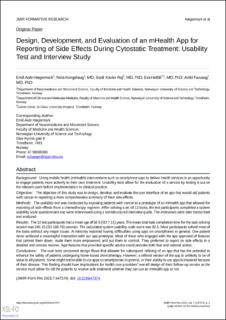| dc.contributor.author | Hægermark , Emil Carl Richard Aale | |
| dc.contributor.author | Kongshaug, Nina Anita | |
| dc.contributor.author | Raj, Sunil Xavier | |
| dc.contributor.author | Hofsli, Eva | |
| dc.contributor.author | Faxvaag, Arild | |
| dc.date.accessioned | 2024-01-12T11:56:05Z | |
| dc.date.available | 2024-01-12T11:56:05Z | |
| dc.date.created | 2023-12-13T09:55:54Z | |
| dc.date.issued | 2023 | |
| dc.identifier.issn | 2561-326X | |
| dc.identifier.uri | https://hdl.handle.net/11250/3111294 | |
| dc.description.abstract | Background: Using mobile health (mHealth) interventions such as smartphone apps to deliver health services is an opportunity to engage patients more actively in their own treatment. Usability tests allow for the evaluation of a service by testing it out on the relevant users before implementation in clinical practice.
Objective: The objective of this study was to design, develop, and evaluate the user interface of an app that would aid patients with cancer in reporting a more comprehensive summary of their side effects.
Methods: The usability test was conducted by exposing patients with cancer to a prototype of an mHealth app that allowed for reporting of side effects from a chemotherapy regimen. After solving a set of 13 tasks, the test participants completed a system usability scale questionnaire and were interviewed using a semistructured interview guide. The interviews were later transcribed and analyzed.
Results: The 10 test participants had a mean age of 56.5 (SD 7.11) years. The mean total task completion time for the task-solving session was 240.15 (SD 166.78) seconds. The calculated system usability scale score was 92.5. Most participants solved most of the tasks without any major issues. A minority reported having difficulties using apps on smartphones in general. One patient never achieved a meaningful interaction with our app prototype. Most of those who engaged with the app approved of features that calmed them down, made them more empowered, and put them in control. They preferred to report on side effects in a detailed and concise manner. App features that provided specific advice could provoke both fear and rational action.
Conclusions: The user tests uncovered design flaws that allowed for subsequent refining of an app that has the potential to enhance the safety of patients undergoing home-based chemotherapy. However, a refined version of the app is unlikely to be of value to all patients. Some might not be able to use apps on smartphones in general, or their ability to use apps is impaired because of their disease. This finding should have implications for health care providers’ overall design of their follow-up service as the service must allow for all the patients to receive safe treatment whether they can use an mHealth app or not. | en_US |
| dc.language.iso | eng | en_US |
| dc.publisher | JMIR Publications | en_US |
| dc.rights | Navngivelse 4.0 Internasjonal | * |
| dc.rights.uri | http://creativecommons.org/licenses/by/4.0/deed.no | * |
| dc.title | Design, Development, and Evaluation of an mHealth App for Reporting of Side Effects During Cytostatic Treatment: Usability Test and Interview Study | en_US |
| dc.title.alternative | Design, Development, and Evaluation of an mHealth App for Reporting of Side Effects During Cytostatic Treatment: Usability Test and Interview Study | en_US |
| dc.type | Peer reviewed | en_US |
| dc.type | Journal article | en_US |
| dc.description.version | publishedVersion | en_US |
| dc.source.volume | 7 | en_US |
| dc.source.journal | JMIR Formative Research | en_US |
| dc.identifier.doi | 10.2196/47374 | |
| dc.identifier.cristin | 2212751 | |
| dc.source.articlenumber | e47374 | en_US |
| cristin.ispublished | true | |
| cristin.fulltext | original | |
| cristin.qualitycode | 1 | |

